Have you ever looked at your content and thought, “I wish this looked better?”
If so, you need to improve your writing skills.
To do so, there are countless tactics you can implement. I’ve written extensively on this before, but today, I want to focus on four critical aspects that I’ve found to be critical to improving your writing skills.
Forget Style, Focus on Matter
I remember when I first started learning about online writing, I used to read the advice from old-school blogging blogs like ProBlogger and Copyblogger. These sites use to say to newbies like me that whenever I wrote, I should:
- Think as if the reader is a 10th grader (or something like that)
- Use the Flesch–Kincaid score
- Use short sentences
- Break paragraphs after every 2-3 sentences
- Use lots of bullet points and sub-headings
Up to this day, bloggers continue to recommend this advice to beginners. I like to think of these tips as the APA style guide of the digital age (if you don’t know, this is the writing style recommended for academic documents by the American Psychological Association). Or, as I like to put it, the “blogging style guide.”
The blogging style guide (BSG from now on) represents the mantra everyone in the industry repeats over and over and which is never to be discussed. Or so it seems.
Let me get this straight: I’m not talking down the BSG. If you have read this blog before, you will see I’m guilty of many of these sins.
I can’t deny it: it works…at least for me.
As someone who suffers from ADD, I like it when a writer uses short sentences and paragraphs. As long as I’m not treated as if I was an idiot—which I believe I’m not—I think these ideas are acceptable.
All of these ideas are meant to help the reader digest your content. When used correctly, the BSG is effective.
But when used to dumb down your content, when it regurgitates previously seen ideas everyone repeats on autopilot—that’s for you, “SEO experts”—then these ideas won’t make your content better.
Bad content written simply won’t make it better; it will be bad content written simply. If this sounds too obvious, it’s because it is.
A piece of content that makes you think how the writer made their ideas seem so simple happens when the ideas presented flow. By “flow,” I don’t mean Mihaly Csikszentmihalyi’s concept; I’m referring to the progressive movement of ideas that make sense in the order they were presented.
If everything you read “clicks,” then the article has flow.
That can be a short, easy-to-read content like Seth Godin’s:
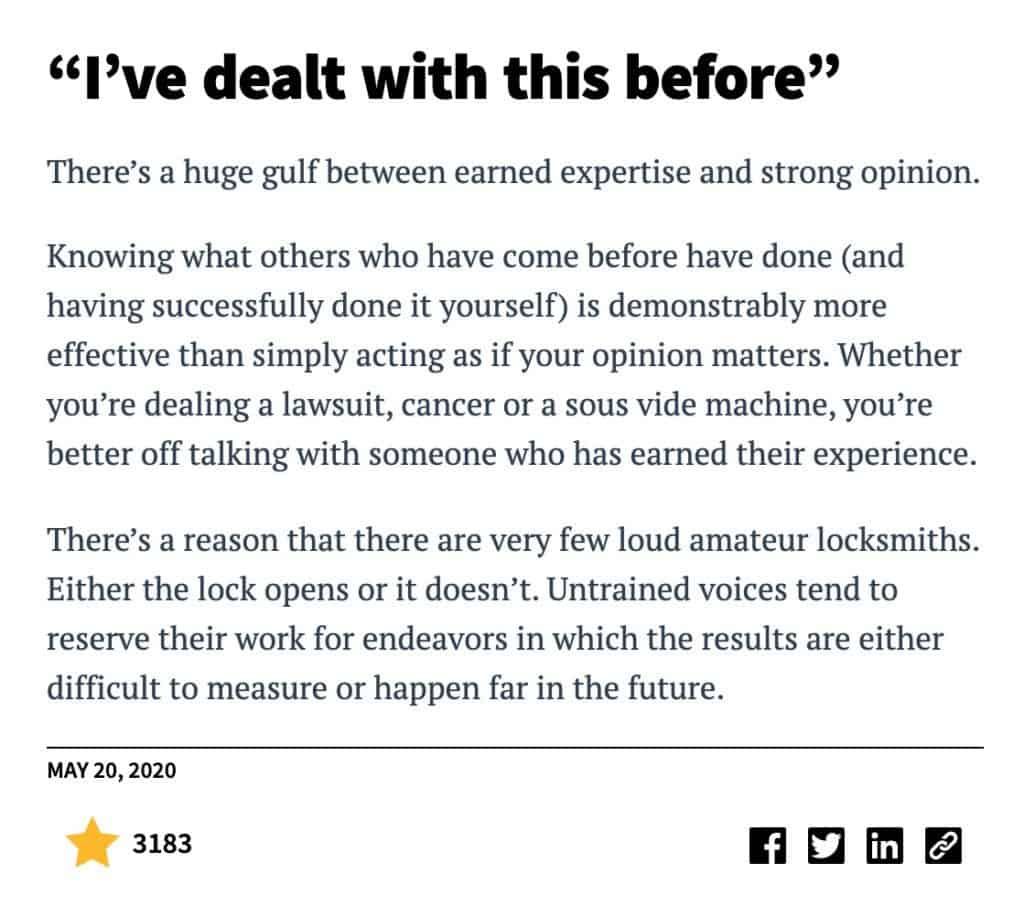
Or it can be a longer, more formal type of content like the one Malcolm Gladwell writes in The New Yorker:
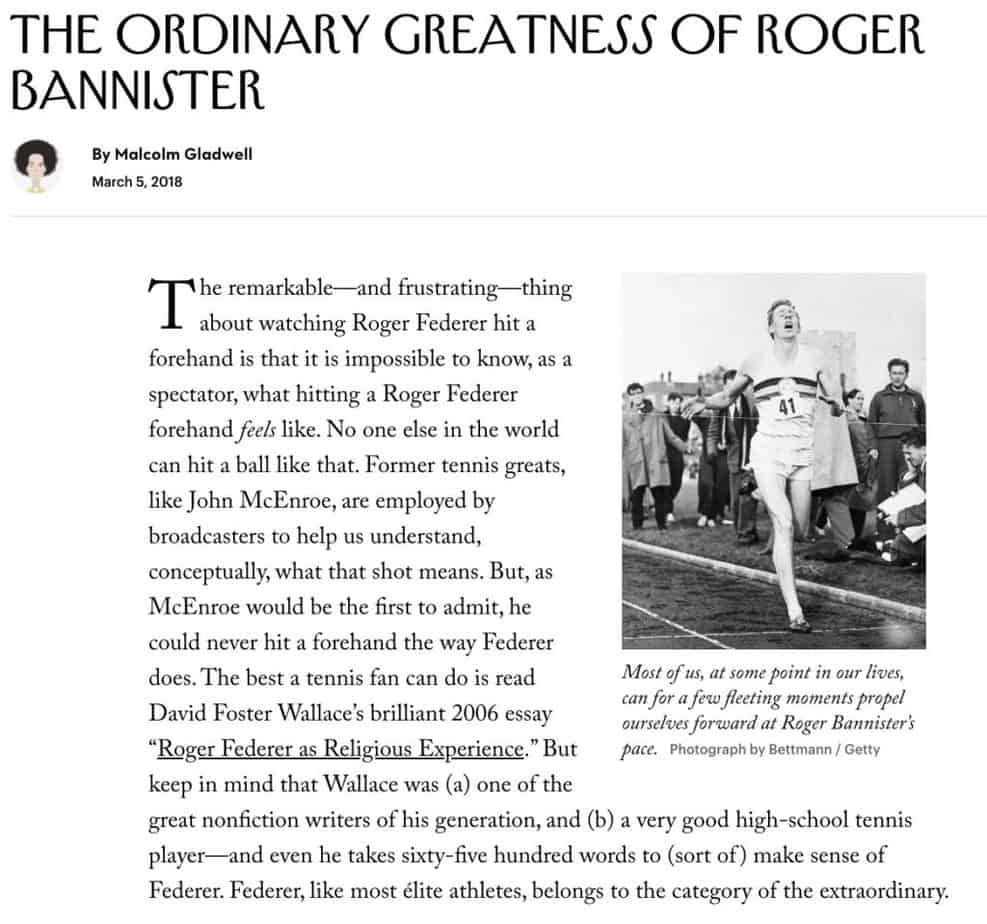
Writing good content isn’t a matter of following the “blogging style guide” because what really matters when you write content is to remember that:
Matter always precedes style.
Or put in another way, the ideas you present in your content will always be above the style you use to present them.
Whenever you are writing content, cut to the chase, and present your premises clearly.
What are you trying to say? Then say it.
Write it down. Cut everything that doesn’t make what you are trying to say clear and leave all the rest.
Who are you trying to say it to? Then speak to that person directly.
For example, I’m writing this piece to writers. I’m writing everything because I know you are trying to improve your writing.
I don’t care if you want to become a freelance writer, or if you make six figures from your content and just want advice, or if you are a marketing manager whose writers were cut and suddenly responsible for writing corporate blog content.
All I know is that you want to write better content. That’s your goal, and so it’s my responsibility to help you fulfill it.
Having a clear idea of the essence of your article will change the impact it has on the reader, regardless of the style you follow.
In every sentence you write, the reader will think “I got it; what’s next?” Conversely, they will think, “this sounds interesting; I want to learn more.“
Every sentence will follow smoothly. Your content will flow.
Regardless of the length of your content, and regardless of the rules you follow, if your content has something to say that the reader truly needs to read, it will be read.
If it weren’t like that, then digital magazines like The Atlantic or The Wall Street Journal wouldn’t exist anymore. They’re not doing well, for sure, but they still exist. People tolerate their “unfriendly” style because the content has essence.
Copywriters like to say that your headline’s job is to get the reader to read the subheadline. The subheadline’s job is to get the reader to read the first sentence of your copy. And so on until they run to get their wallets and purchase whatever it is the copywriter is selling.
Similarly, your content should have something that has a meaning and a reason to exist. Stuffing a keyword in your content won’t do it.
It’s something that you can only know and which must be clear. If it is, I can guarantee you that your content will be read, no matter how you present it.
Learn from the Best
The process of improving your writing skills requires a lot of study and practice. One way is to study grammar, the rules that structure the composition of the English language.
I won’t discuss the effectiveness of doing so, but you probably know as well as I do that this is a tiresome process. It may not even translate to an improvement in your writing if you just keep your study to the theory alone.
A much more interesting, fun, and practical way to improve your writing fast is to learn from the best. By this, I mean:
- Reading writing books
- Reading your favorite writers
- Analyzing and copying your favorite writers
Read Writing Books
If you have read my past content, you know I’m a big fan of writing books.
I’ve read a dozen books on this topic, and I have to admit that I would not have improved as much as I did if it wasn’t for them. Look at this old guest post and compare it with this more recent one, and you will notice the difference.
My writing style is more polished. My ideas are better organized. My content is clearer. A big part of this change happened because of the writing books I read. These books taught me:
- Grammar—the rules that structure the language
- Writing style—the way to present my ideas
- Writing technique—the way to organize my ideas
If you want to learn about writing as I did, I recommend you check out my article where I mention my ten favorite writing books: 10 Best Writing Books to Develop Professional Skills.
Read Your Favorite Writers
Reading books that analyze great content is a significant step forward in the right direction. But another way is just to read the writers you like the most and learn by osmosis.
By “osmosis,” I mean the slow and unconscious way to absorb information through exposure. You read and read, and without you realize it, you end up learning the techniques from the writers whose books you read.
It’s like the movie Inception, but instead of having Leonardo Di Caprio and Ellen Page get in your brain to hack secret codes, you get Chuck Palahniuk show you how to write like a badass.

Instead of buildings, imagine words bending in your unconscious. Source
I’ve found that after I read an article or book written in a formal, traditional writing style, my content ends up looking formal and traditional.
For example, a writer like Ron Chernow presents his ideas in a formal, academic way. When I read his biography of John D. Rockefeller, I noticed he used a lot of abstractions (nouns) and little descriptive and emotional verbs. Take a look at this small excerpt from his book:
Rockefeller equated silence with strength: Weak men had loose tongues and blabbed to reporters, while prudent businessmen kept their own counsel.
If you notice, the sentence looks solid but dry. The author doesn’t get in the way of the description; he describes what Rockefeller thought and nothing more.
Whenever I read books like these, my writing always ends up looking more formal. I present ideas like Chernow would:
- I start with a subject (or a noun if there’s no subject available)
- Then a verb that makes the subject “move”
- I finish with a noun that describes or conceptualizes the subject.
If you put it this way, the content looks more static; it seems as if the ideas I present are the truth, and the person explaining them (i.e., me) was an academic. A bit pedantic, I know, and even a little funny because I don’t expect to use this style in my writing, but it happens more often than you’d think.
Similarly, you can decide on a specific writer that you somehow like and focus on reading their style slowly so you can absorb their manner of writing. You can make a list of a bunch of articles from a writer you admire and read them all in a short period.
Conversely, you can read a book or two from a writer you like to intensify your learning. Slowly, you will absorb their writing style and techniques.
Analyze and Copy Your Favorite Writers
Learning by osmosis is an indirect way to absorb the style and technique of a writer you admire. An even better and more direct way to do this is to break down a piece of a writer you like to uncover their style and technique.
As an example, let’s take Ryan Holiday, a writer I like. There’s a lot we could analyze, but to keep this concise, let’s focus on the introduction for the article “This Is What a Good Day Looks Like–According to Marcus Aurelius”:
It’s humbling to think that Marcus Aurelius, the head of the most powerful empire on earth, had the same amount of hours in the day as you.Just 24.So how did he get it all done?How did he have time to be a king, a philosopher, a writer, a husband? To pass laws and judge cases? To lead troops into battle and guide Rome through a terrible plague? And do this while remaining good? Without being corrupted by the temptations or the stress of his position?Well, routine had something to do it. He was a man of habit—all the Stoics were. They understood, as Aristotle did, that we are what we repeatedly do. That excellence is a habit.For Marcus, the day started early. “At dawn, when you awake,” he wrote, “know that you are getting up to do the work of a human being.” There was no time to stay under the covers and stay warm.
Deconstructing his writing, here’s what I can observe:
- He starts by stating the most amazing fact of all: that Marcus Aurelius, the most powerful man in the second half of the first century A.D., had as many hours in the day as we do.
- He breaks down that fact in two paragraphs: in the first one, he mentions the fact, and in the second one, he reinstates the point. Most interestingly, the first paragraph is interesting and long, while the second one is two words long.
- He stirs up interest by asking a short question in the also short third paragraph.
- He pushes hard on the open gap of interest in the fourth paragraph, asking five questions.
- He uses the art of tempo and rhythm within the first five paragraphs—long sentence, short sentence, short question, long questions. If someone reads this aloud, you’d understand how this tempo and rhythm sounds in your head.
- Finally, he gives two answers right away in the next two paragraphs.
Based on this quick analysis, I can then copy his style on my own pieces. I know I will use some of the insights found above in my articles.
If you like a writer, but you can’t seem to see what makes you like that writer, do this analysis for an entire piece. If you like how a writer works a section of an article, like an intro or conclusion, repeat this analysis just on that section you like.
After you carry out the analysis, you should then write a piece like you normally would. But here’s where things get interesting:
Once you have finished writing, re-read your piece and compare it to the writer.
Do you see any differences? If so, can you change some elements and make them look closer to the writer’s style?
The more you do this type of deconstruction and comparison, you should start to develop the style of the writer you like. The more you practice, the more that style will impregnate in yours. Before you know it, your writing style will become the sum of your own preferences and skills with the style of those writers you like.
Take the Time
One of the tragedies of becoming a freelance writer is that you transform something you love and like doing into an obligation. You invest most of your time to talk with your clients, working on their deadlines, their topics, and their needs.
At first sight, there’s little to complain about. Every working relationship comes with such obligations. But if you stop investing the time to do your job properly to manage your clients, your content will suffer. And your readers will notice that too.
Writing great content takes time. Researching ideas your readers love takes time. Editing your content until it shines takes time.
It all takes time.
If you can simply put more time into your writing process, I can guarantee your quality will skyrocket.
There’s no time limit or goal you need to hit. For me, writing a good article takes one or two days. I know my quality starts to dwindle after the two to three-hour time frame, the time it takes me to write anywhere between 1,500 to 2,500 words.
My advice doesn’t focus on the writing process alone; you also need to put time into your research, outline, and edit.
I can’t tell you how many times I’ve thanked my past self for doing thorough research during the outlining—the first part of my writing process.
Spending a few hours exploring my ideas, searching for statistics, examples, and references makes my writing smoother and more enjoyable once I get to it.
The problem is that I’m lazy, so I often avoid doing this and just throw a few ideas and figure out the rest later. Easy, for sure, but a pain once my hands are on the keyboard.
Often, I overcome this shortcoming by spending more searching for stats, examples, and references while I write or once I’m editing it. But that’s way more painful to do; I get distracted easily, and I can’t tell you how often I end up wasting time searching for data when I should be writing. Worst yet, my piece ends up looking disorganized.
When I forget about taking the time to create good content, my output takes a hit. And so will yours if you don’t take this same precaution.
Remember, great writing takes time.
Rushing through your projects to hit your deadline and make a living may help you be more productive and profitable, but it won’t make you more effective.
If you rush your articles because you can’t make a living out of your existing volume, you need to charge more.
Once you make more per article, you will work less—fewer clients, less content to write—but you will work better. You will compensate for your decreased volume by increasing your margins.
Consider using productivity apps to organize your tasks better and taking a day off just to do each part of your writing slowly. A to-do list app—Microsoft To Do or Todoist are two good examples—and a calendar app will be all you need.
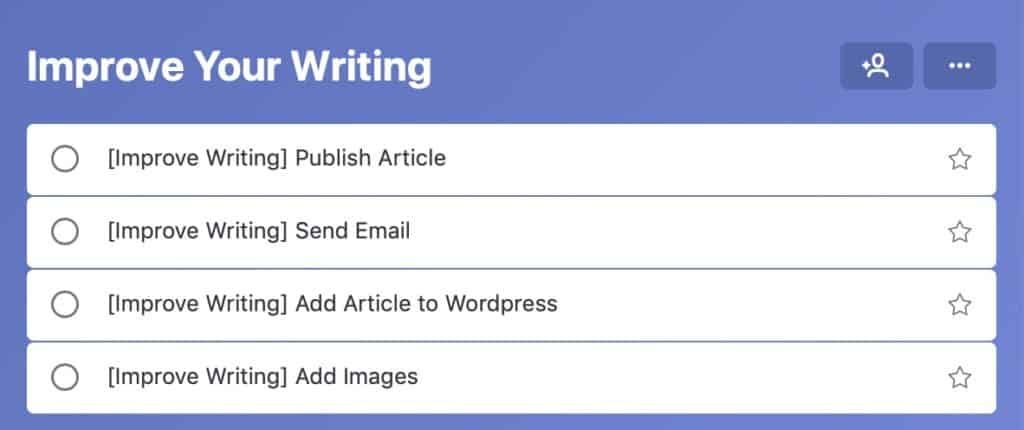
These are four tasks I created to organize my work around this piece, don’t tell anyone.
Organize your ideas. Use a notepad, a note app, or an editor like Evernote or Bear and put your thoughts together. I recommend developing an outline first with the main ideas you want to explore in your piece.
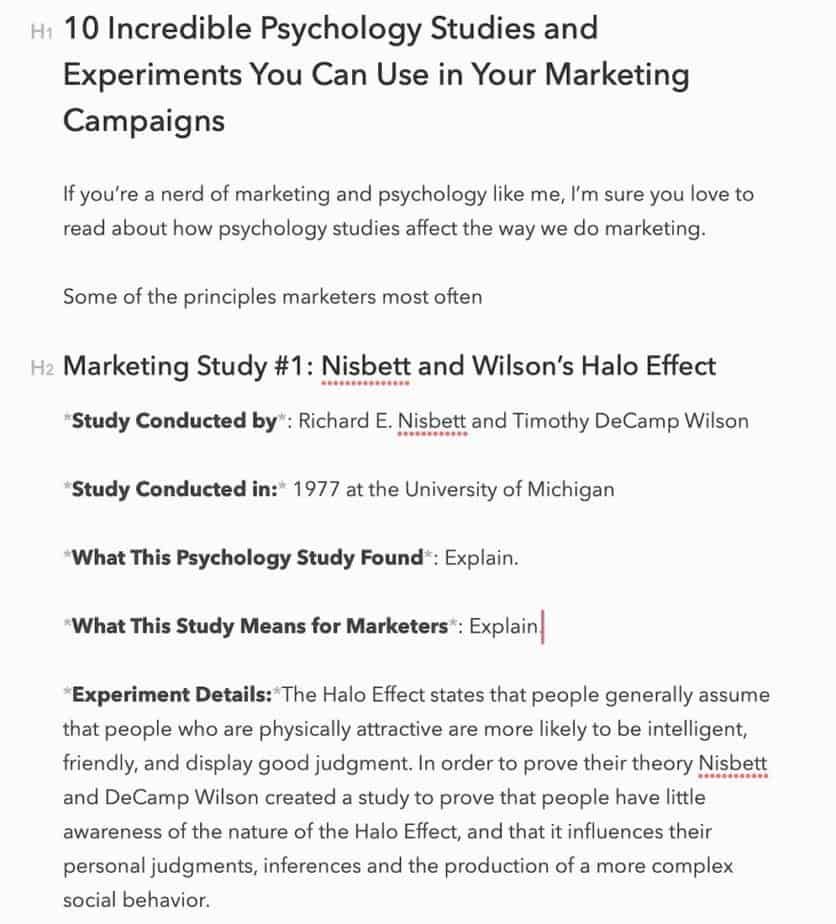
Research everything before writing. Even if that means finding a few sources and examples, researching your piece before you start writing, it will help you create a much more consistent article later on.
Remember to get your sources right, whether that includes adding links from the sources (i.e., reports, studies), interviewing people and quoting them, and checking these sources to make sure they’re right.
It’s easy to link to studies and stats from other posts, but you’d be surprised most people just link to other sources without checking them. You may find dozens of articles quoting the same statistic without knowing that the original study is no longer available, it’s outdated, or that the full quote is off-mark.
No matter how you plan to organize your content writing, just remember: take the time. Your readers will thank you for it.
Sell Your Ideas
Whether you know it or not, you are always selling.
No, I’m not saying you should be like a sleazy telemarketer selling snake oil to a gullible person, as it often happens. You should never try to force your way through your customer’s pockets.
That’s not what selling is about—quite the opposite.
According to Daniel H. Pink, author of To Sell Is Human, “to sell well is to convince someone else to part with resources—not to deprive that person, but to leave him better off in the end.” [Emphasis mine.]
Based on Pink’s definition, you need to offer your readers something that makes their lives better:
- A useful piece of advice
- A practical tutorial
- A thought-provoking opinion
Following Pink’s definition of selling, your articles should leave your readers better than before they read it. You need to make an effort to make it clear to the reader what they will get from your piece.
There’s hardly a better place to add this benefit to the introduction of the article. If you check the one from this one, you will see I wrote:
Have you ever looked at your content and thought, “I wish this looked better?”
If so, you need to improve your writing skills.
To do so, there are countless tactics you can implement. I’ve written extensively on this before, but today, I want to focus on four critical aspects that I’ve found to be critical to improving your writing skills.
Behind these words, you can see I used a structure that works like this:
- I asked you, my reader, about a problem you have probably faced.
- I told you what you need to do to solve this problem.
- I told you to read this article because there are several ways to implement this solution.
I can synthesize this introduction even further by organizing it like this:
- Start with a problem.
- Offer a solution.
It doesn’t get any simpler than this. How you like to go over this problem and solution can take three paragraphs like I did in this article, or it can take many paragraphs and hundreds of words.
I won’t get into the details of which option is best, as that depends on several factors, including the publication, the audience, and your writing style. The point is, focusing on the problem and then the solution is the way to go to sell your idea right from the start.
This idea of starting with a problem and offering a solution to it isn’t mine—not even closer. I took this idea from copywriters, who have mastered the art of catching people’s attention for decades.
Drew E. Whitman, the author of one of my favorite writing books, Cashvertising, has a similar theory, which he calls the “formula for desire.” While his structure is geared towards copywriting, you can still adapt it in your introductions as it’s similar to the two-step process I use.
The formula for desire looks like this:
Tension → Desire → Action to Satisfy the Desire
According to Whitman, the introduction has to build tension. That is, it needs to touch on a need that has not been met.
In this article, I focused on your desire to overcome the frustration of writing something you don’t like as much as you’d like to.
Whether you write educational content, case studies, ebooks, or sales copy, all your content solves a problem for your reader. The consequence of that problem is the thing that’s annoying the reader. If you can make it clear to your reader that you know what this problem is and the tension that it causes, you’ll strike gold.
As soon as you build the tension, you need to explore the desire. The tension you have built should immediately relate to their desire to overcome it.
I know you don’t like looking at your content and think you could have done it better—I do it myself from time to time. In this introduction, I didn’t explore this desire because I preferred a punchier opening that goes straight into the solution.
But if I have done it, I would have written something like this:
Wouldn’t you want to finish a piece while sipping your coffee and think to yourself, “I did a great job”?
Imagine how this would feel. Imagine the satisfaction of knowing that your content gets complemented by its wording and narrative instead of the paycheck you get at the end of the month.
Wouldn’t this feel awesome?
If so, then you need to improve your writing skills.
I’m no copywriter, and this is far from the A+ copy professionals write, but it’s still an approximation of how exploring the desire works.
You can do this type of “desire exploration” by writing about the implications of solving your audience’s problems.
While it’s not mandatory to do it every time—remember that it’s a copywriting technique, not a content writing one—you should sprinkle this technique every so often. It will add an extra layer of intrigue that your readers will love.
Finally, you need to describe the action to satisfy the desire. You must tell what the reader needs to do to solve the original tension you arose before.
In my case, and yours too, is to tell the reader that reading the article will solve the original tension. It’s the call to action for the reader to keep on reading, nothing more.
To make this action even more desirable and satisfying, you can add proof like:
- Adding your experience in the subject matter—think years or a degree that backs your expertise.
- Sharing a result from someone who did what you recommend—think a case study.
- Sharing the popularity of your solution—think of those who have praised you or those who have used your solution.
If you think about your article’s premise as a tool your readers can use to improve their lives, you will realize that it’s your obligation to sell it to them. Then, you need to do it like I just showed you.
Edit Like a Pro
When I first started writing, I remember that I used to put most of my effort into the writing. I thought that the best ideas came when I was working shoulder to shoulder with my muse, putting the ideas I got in my head into the blank screen in front of me and chiseling them until they look the way I imagined them in my head.
But as I said before, writing is just a part of the entire writing process.
If you did your research properly, writing should be relatively easy. In this case, the writing puts all the ideas defined in the outline into cohesion. There’s no head-hitting-the-table part because the hardest one—defining the “what” of the article—was already figured out before.
So what else is there to do? Do you just pat yourself on the shoulder and call it a day?
No, not even close.
Your content needs editing—a lot of it. It’s easy to let your ego speak for yourself and believe you have finished your work once you stop writing. But that’s what amateurs writers do, not professional ones like yourself.
The moment of truth comes when you look at your baby, and you realize it’s not what you originally conceived; it’s the part where you let go of your pride, pick up the sandpaper, and polish it from head to toes.
A common practice writers have always used is to take some time between the writing and the editing of a piece.
In my experience, this idea works great, and you should use it too. I’ve found that the more you leave your canvas to dry out, the more you detach yourself from it, and the better you improve it later on.
I have found waiting a week between writing and editing has the best cost-benefit. In most cases, however, I don’t have the luxury to wait for so long. A day or two is the most I can usually take, and while it’s not ideal, it’s better than editing a piece the same day I finished writing it.
When you sit down to edit your piece, there are three things you should do:
- Read every sentence carefully.
- Read your words out loud.
- Use a grammar app to find syntax, grammar, or spelling.
In every sentence and paragraph, make sure to aim for clarity and conciseness. Ask yourself, “what did I mean by this?” If you aren’t sure, you will need to rewrite it.
Reading your words out loud will highlight the pace of your article. Some pieces have way too many words, parentheses, and sentences that delay the impact of your ideas.
Other times you’ll find that what looks good on paper doesn’t sound right. I always rephrase the words that don’t sound good because while most people don’t read aloud, they speak in their heads. That inner monologue is quite powerful to make your content more engaging, so listen to it when you edit.
Finally, there’s little to say about getting your grammar in check because, without it, your piece will suck.
Ideally, you should be aware of the basic grammar rules so you can write without making mistakes, thus saving yourself a lot of time.
But no matter how smart you are, you will make grammatical errors. That’s why you should use a grammar checker like Grammarly to check your work and find any errors you make.
After I finish editing my pieces, I run it through Grammarly. Every time, it finds lots of mistakes that if I hadn’t noticed them, I would have felt ashamed for having published my piece. It also gives recommendations about your content’s correctness, clarity, engagement, and delivery.
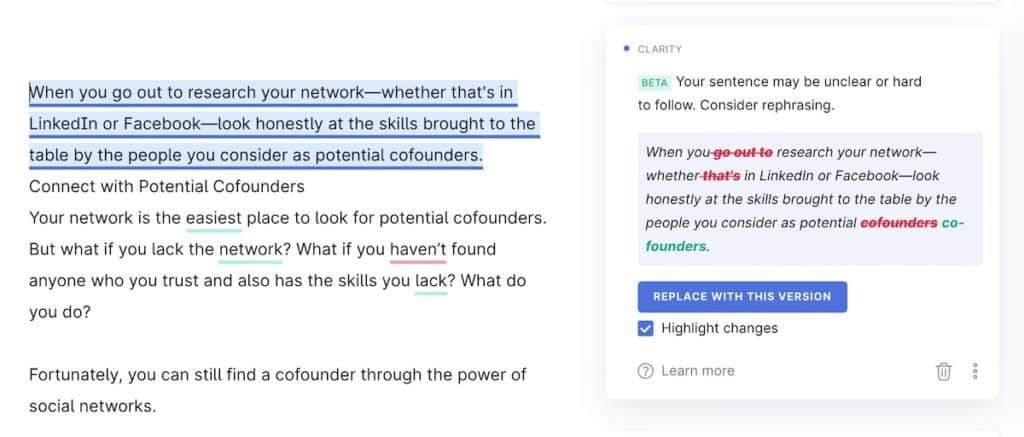
Whether you use the paid version or not isn’t important; the free one is already enough for most beginner writers. But I can’t stress enough how good the premium one is once you start getting published in more prominent, more influential publications. I’ve already written an extensive review of Grammarly, so please check it out to understand how it works.
I’d recommend you give it a go and try it for yourself (it also helps me keep running this blog, and I’d really appreciate it if you tried it, even if you only get the free version of the app).
Improve Your Writing Once and for All
Having a profound love for your writing craft is the first step to improving your writing skills. But writing persuasive and engaging content takes much more than passion; it requires discipline and a mastery of technical skills.
These writing tips have taken years to take root in me. I hope that now that you know them, you will too improve your writing and start creating articles that make you a more influential writer.
I’d love to hear your thoughts below.
